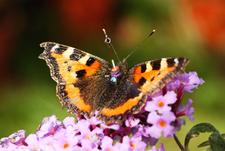 The charming meanderings of butterflies are not as random as they appear, according to new research. Scientists at Rothamsted Research, a research institute sponsored by the Biotechnology and Biological Sciences Research Council (BBSRC) in Hertfordshire, have found that their seemingly irresolute flutterings are in fact decisive flight paths. The harmonic radar has been used before to track the flights of bumblebees and honeybees. Now it has been shown to work for butterflies too, opening a new window on the flight behaviour of these important pollinating species.
The charming meanderings of butterflies are not as random as they appear, according to new research. Scientists at Rothamsted Research, a research institute sponsored by the Biotechnology and Biological Sciences Research Council (BBSRC) in Hertfordshire, have found that their seemingly irresolute flutterings are in fact decisive flight paths. The harmonic radar has been used before to track the flights of bumblebees and honeybees. Now it has been shown to work for butterflies too, opening a new window on the flight behaviour of these important pollinating species.
BBSRC-funded researcher Lizzie Cant has attached tiny radar transponders, weighing only about 12mg (4-8% of body weight), to peacock or small tortoiseshell butterflies. This allows her to use harmonic radar to track the butterfly’s position accurately up to 1km away. Previous studies had to use visual observation (difficult over 50m) or indirect mark-recapture techniques.
Butterflies were tracked undertaking fast, directed flights to potential feeding sites or interspersing periods of foraging with looping “orientation” flights. Knowing how butterflies navigate can help us understand how capable they are of maintaining sustainable populations in our increasingly fragmented countryside.
Lizzie Cant said, “Butterflies are important pollinators, providing a crucial service to plants in many ecosystems. This research will help us to understand a little more about how they survive in a countryside that is becoming more and more fragmented."
Tracking butterfly flights across the landscape with harmonic radar by Cant, E.T. Smith, A. D Reynolds, D.R. Osborne, J. L. In: Proceedings of the Royal Society B.
Source : BBSRC
Image Source : Butterfly with antenna attached, BBSRC and Rothamsted Research.
 Print Article
Print Article Mail to a Friend
Mail to a Friend
